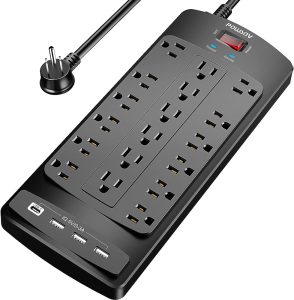Protecting your valuable electronics from unexpected power surges is paramount for ensuring their longevity and reliability. A power surge protector plays a critical role in this endeavor by providing a defense mechanism against voltage spikes. This guide delves into the nuances of selecting, installing, and maintaining power surge protectors to safeguard your electronics.
Understanding Power Surge Protectors
What is a Power Surge Protector?
A power surge protector is a device that shields electronics from voltage spikes by diverting excess electricity to the ground before it can reach and damage connected devices. These devices are essential for anyone looking to protect their home or office electronics from unpredictable power surges.
How Do Power Surge Protectors Work?
Power surge protectors monitor the incoming voltage and automatically redirect any excess to the grounding wire, significantly reducing the risk of damage to connected devices. This process involves the use of internal components such as metal oxide varistors (MOVs) that absorb the extra voltage and safely dissipate it.
Key Features to Consider
When choosing a power surge protector, it is crucial to consider several key features to ensure comprehensive protection for your electronics.
Joule Rating
The joule rating indicates the energy capacity of a surge protector. Higher joule ratings offer better protection. For household electronics, a protector with at least 600 to 1,000 joules is recommended. For more sensitive equipment, such as computers or home theater systems, look for ratings above 2,000 joules.
Response Time
Response time is critical for a surge protector’s effectiveness. Opt for devices with a response time of less than one nanosecond to ensure rapid protection against voltage spikes.
Number of Outlets and USB Ports
Consider the number of outlets and USB ports you need. A good surge protector should accommodate all your devices without overcrowding. Models with rotating outlets or cord management features can help organize your space efficiently.
Warranty and Equipment Protection Policy
Manufacturers often offer a warranty or an equipment protection policy, covering damages if the surge protector fails. Look for policies with comprehensive coverage and a straightforward claims process. Some policies offer up to $100,000 in equipment protection, providing peace of mind and a testament to the product’s reliability.

Installation and Maintenance Tips
Correct Installation
Ensure correct installation by connecting the surge protector directly to the wall outlet and not to another extension cord or surge protector, as this can reduce its effectiveness.
Regular Testing and Replacement
Test your surge protector regularly using the built-in test function, if available. Surge protectors have a finite lifespan, typically around three to five years, or after a major surge event. It’s crucial to replace them as needed to maintain protection.
Positioning for Optimal Performance
Position your surge protector in a location where it can dissipate heat effectively, away from direct sunlight and moisture, to prevent overheating and potential damage.
Conclusion
Investing in a high-quality power surge protector is essential for anyone looking to safeguard their electronic devices from voltage spikes. By understanding the key features, installation, and maintenance of surge protectors, you can ensure your electronics are well-protected for years to come. Remember, a small investment in a surge protector can prevent costly repairs or replacements of your valuable electronics.